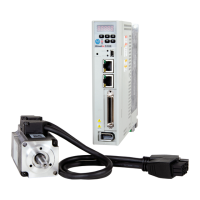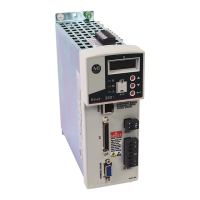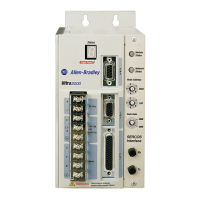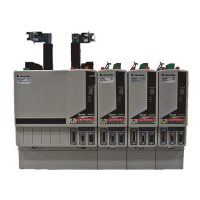Rockwell Automation Publication 2198-UM004A-EN-P - October 2019 393
Absolute Position Recovery Chapter 14
Pulse number = m (cycle number) x 16777216 + pulse number (0 … 16777215).
The conversions between pulse number and PUU are as follows:
When the rotation direction is defined as clockwise (CW) in ID117
(P1.001.Z=0), then the PUU number =
pulse number × [ID152 (P1.045) / ID151 (P1.044)] + ID398 (P6.001).
When the rotation direction is defined as counter-clockwise (CCW) in ID117
(P1.001.Z=1), then the PUU number =
(-1) × pulse number × [ID152 (P1.045) / ID151 (P1.044)] + ID398 (P6.001).
PUU Number
The PUU number is a 32-bit absolute value with positive and negative signs.
When the motor is running in the forward direction, the PUU number increases;
when it is running in the reverse direction, the PUU number decreases. The
forward direction does not mean that the motor is running clockwise; the
direction is defined by ID117 (P1.001.Z). If the PUU number exceeds the range
-2147483648 … 2147483647, the position counter overflows and A 289 occurs.
Reinitialize the system to clear the fault A 289. You can determine A 289 when
the position overflows through ID243 (P2.070). When reaching the maximum
PUU number in the forward direction, the value changes from
2147483647 to -2147483648, -2147483647, until 2147483647, and so on. The
value changes the other way when the motor operates in the reverse direction. See
the following examples:
Example:
When ID151 (P1.044) = 16777216 and ID152 (P1.045) = 100000, the motor
needs 100,000 PUU to run a cycle. 2,147,483,647 ÷ 100,000 = 21,474.8, so after
the motor runs over 21,474.8 cycles in the forward direction, A 289 occurs.

